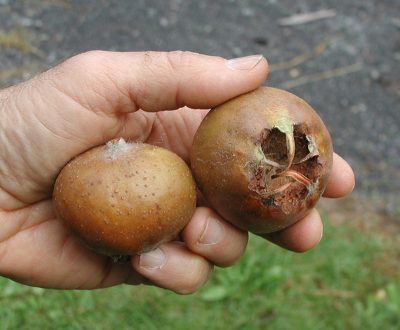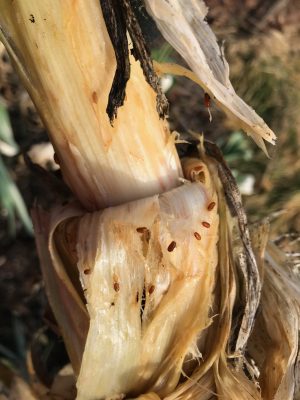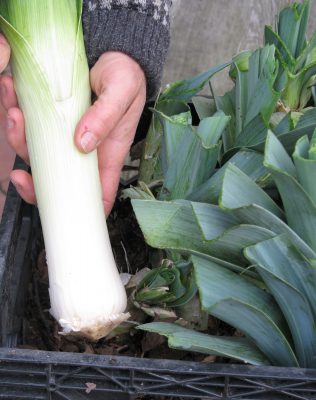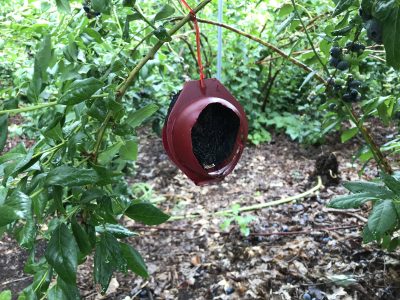Dry, Wet, Bad, Good?
Some Bad
Wow! What a gardening year this has been. Looking back on 2018, it’s been the oddest year ever in terms of weather, insects, and disease.
After starting off the season parched, seemingly ready to go into drought, the weather in July did an about face. The rains began. Average precipitation here in the Northeast is about 4 inches per month. July ended up with about 6 inches, August saw 5 inches, September 8 inches(!), October 5 inches, and November 8 inches(!!).
All that rainfall brought humidity, which might have been responsible for my celeriac plants hardly growing, then rotting.

Celeriac, early in the growing season, before the rains
(Perhaps not, because this was my third growing season of failure with celeriac.) I’m taking this as a celeriac challenge. Perhaps next year I’ll try them in a large tub where I can have more control over soil composition and moisture.
The humidity also had too many figs morph into fuzzy, gray balls as they softened and sweetened.
Tomatoes this year tasted very good, as usual, but yield was way down and too many showed some rotting areas. (In my experience, growing tomatoes under variable soil and weather at various locations around the country, their flavor is mostly a matter of genetics; a good variety tastes good everywhere.) Particularly irking was anthracnose disease, which often isn’t noticeable when fruits are harvested, but quickly shows up as round, sunken areas.
Onions suffered this season. Mostly they were stunted, and I’m not sure why.
Zucchini was a bust because the plants petered out from powdery mildew and vine borers just after midsummer. I usually circumvent these common problems with multiple plantings, starting new zucchini plants in early summer to replace the decrepit ones. I forgot to replant this summer (probably because I don’t like zucchini all that much anyway).
Medlar is an uncommon, very old-fashioned fruit that I’ve grown for many years. Although it’s gotten a bad rap for it’s ugly — to some people — appearance, the flavor is delicious, the soft flesh creamy smooth like apple butter with a similar flavor livened with vinous overtones.  Usually the plant is pest-free but a few years ago something, perhaps a fungus, perhaps an insect, started attacking it, leaving the flesh dry and crumbly. I have yet to identify the culprit so that appropriate action can be taken.
Usually the plant is pest-free but a few years ago something, perhaps a fungus, perhaps an insect, started attacking it, leaving the flesh dry and crumbly. I have yet to identify the culprit so that appropriate action can be taken.
Some Good
Not that this past growing season was bad. I won the battle against soft scale insects (mealybugs) on my greenhouse figs, although their ecological niche was filled by just-as-bad armored scale insects. A close eye and an occasional spray of Neem oil kept flea beetles at bay from eggplants.
A couple of the same Neem sprays beginning in mid-September may have kept a new pest in the area, Allium leafminer (ALM, Phytomyza gymnostoma) at bay. Last year each of my near perfect-looking leeks revealed a rotted stalk as I lifted them out of the ground.

Allium leafminer
Then again, I did plant this past season’s leeks far from where the previous season’s leeks grew. Then again, the ALM flies can fly. Then again, maybe they weren’t here this year; perhaps the weather was not to their liking.

This past season’s leeks
There was also no sign this past season of the white flies that decimated my kale the previous season.
Spotted wing drosophila (SWD), a species of fruit fly that has invaded the country relatively recently, did mostly ruin autumn ripening yellow and black raspberries. But little damage was suffered by my favorite (and perennially most successful) fruit, blueberries, probably thanks to some experimental traps developed by Peter Jentsch of Cornell University.

SWD trap
Peppers were even more of a success than usual, mostly due to my staking the plants. The only fault of Sweet Italia, my favorite variety for its early ripening, for its flavor, and for its good yields, is that the fruit-laden plants flop over under their own weight. Eventually, the small bamboo stakes I used proved only partially adequate; next year they’ll get the stakes they deserve.
I treated a few beds in spring to a relatively new method for weed control: tarping. Laying a sunlight-blocking tarp down on the ground for a couple of weeks or more in spring warms the soil beneath, stimulating germination of any weed seeds lurking there. The sprouting seeds are disappointed by the incessant darkness. They die. Timing, temperature, sunlight, and duration of tarping all play a role in this techniques effectiveness.
(Tarping is very different from using black plastic mulches. The latter are kept in place all season long, with garden plants growing in holes or slits in the plastic. Soil beneath the plastic can suffer from lack of air or, if not drip irrigated, lack of water. Also, the tarp — mine came from www.billboardtarps.com — can be folded up and re-used for many seasons.)
And finally, we were happy to find some assassin bugs and anchor stink bugs, Stiretrus anchorago, in the garden. Both are beneficial insects — yes even that particular stink bug.

Immature beneficial stink bug
Good Overall
All in all, it was a good season — as always. The secret is to grow many different kinds of plants. No season, no matter what the weather or pests, has ever been bad for all plants.

